James Watson
-
- A Look into ABS with James Watson Marine News, Jan 2014 #12
When ABS, the global provider of maritime classification services, announced that James A. Watson had been named President and Chief Operating Officer of their Americas Division, it wasn’t hard to see why. Likewise, there were few if any other candidates for the job with as well rounded a CV, and with the breadth of knowledge spanning the full range of maritime issues. Formerly the Director of the Bureau of Safety and Environmental Enforcement (BSEE) and before that, Watson served as the U.S. Coast Guard’s Director of Prevention Policy for Marine Safety, Security and Stewardship, where his responsibilities included commercial vessel safety and security, ports and cargo safety and security and maritime investigations. Notably, he was designated as the Federal On-Scene Coordinator for the government-wide response to the Macondo oil spill in the Gulf of Mexico in June 2010. Beyond this, Watson graduated in 1978 from the U.S. Coast Guard Academy with a Bachelors of Science degree in Marine Engineering and holds Master of Science degrees from the University of Michigan in Mechanical Engineering and Naval Architecture in addition to a Master’s degree in Strategic Studies from the Industrial College of the Armed Forces. Based at the ABS Division’s headquarters in Houston, Watson hit the ground running in September. Read on to see what he’s been up to since:
You’ve been on board at ABS now for four months and this assignment follows two other similarly high profile, c-level assignments at both BSEE and the U.S. Coast Guard. What’s different about each of these posts, what is the same and what “take-aways” from the previous posts will you bring to ABS in your new role?
ABS’ mission is to promote the common safety, while the Coast Guard and BSEE naturally follow a regulatory approach. Despite the different approaches, they have similar goals and a similar heritage. They exist to serve the maritime industry and the public interest by working to reduce the likelihood of accidents and improve working conditions at sea. Each is built on a foundation of sound standards, highly competent engineers and field professionals, and a genuine interest in the success of the maritime industry. As a Coast Guard officer, my job involved maritime response as well as prevention. While I was at BSEE, I embraced its safety and conservation mission, which is strongly linked to natural resource management. At ABS, I have added the objective of serving the maritime and offshore industries by helping them meet their desire to run a safe ship or rig while managing costs and downtime. Coming from Coast Guard and BSEE, I bring a conviction to achieving safety through a balanced, risk-based approach. I’m convinced that good ship management and seamanship are critical, but I also believe in the value of experienced engineers and surveyors. I believe leading indicators precede every accident; so safety is a matter of collectively reading the indicators and taking action at the right time.
Safety evolves over time – in the Coast Guard, in the commercial world, at BSEE and – at ABS. In all four worlds, safety also involves managing risk. All four approach the challenge a little differently. Your perspective brings them all together. How so?
Maritime professionalism, established standards and protocols, and a constant respect for changing risk conditions are essential for safety. My strategy encompasses all three, and I believe Coast Guard, BSEE, ABS, and commercial operators all have obligations to do their part. Since these organizations are large, widely spread, and usually focused on technical details, there’s value in having someone to strengthen the common ground. I envision having that role. My new position at ABS is ideal because of the added responsibility I have to the commercial operators and marine industry leadership. While government leadership is well defined, industry leadership can be pretty diverse. I pride myself in being both a listener and a communicator. So, I hope I can be a good conduit for information and understanding. I believe reason and consensus can prevail in every difficult vessel construction and maintenance decision. Safety, environmental protection, and efficient commerce are in everyone’s interest. As president of the ABS Americas Division, I plan to emphasize the many agreements and practices that these organizations already share in order to form the new policies and practices we will need to keep the industry moving forward. When industry moves to new environmental standards or embraces more efficient technology, we have to also consider the safety of the asset, its cargo or the crew. It is essential to fully understand risk tradeoffs as we begin implementing innovative technologies so the best informed decisions are taken across the board.Give us some examples.
An example is mitigating risks that can be unintentionally introduced by installing equipment or systems necessary for compliance with particular environmental regulations or in the interest of energy efficiency. Class is taking a more holistic approach to the role of defining safety. In many cases, that means addressing areas that are not specifically covered by statutory regulations, such as equipment integrity, redundancy, equipment safety, operational safety and aspects of maintenance. Increasingly we are required to provide some type of formal safety assessment as a condition of classification approval of certain onboard installations. Today’s technology, knowledge and experience, and the availability of performance data are providing the foundation for a new, more effective approach to safety. We know that the next generation of maritime regulations is going to be driven by data to a degree that has not been seen before. The challenge of big data is selecting the “right” data from the data flow to develop a data-driven classification cycle, which replaces the calendar-based approach to class and regulatory surveys that has been with us for more than 200 years. I am pleased to see and be a part of this transformation. Corporate leaders have the opportunity to act as role models for safety and safety culture. This happens through direct action – providing resources of time, personnel and money as well as empowering workers to work safely. This type of commitment helps to create an environment of mutual trust and is the keystone of a positive safety culture. ABS is this type of leader.
The Arctic is a focus of the Coast Guard, ABS and BSEE, all arguably for different reasons. Change is coming quickly there. Are Class, the regulatory and commercial sectors ready for what comes next?
The Arctic is a frontier. Americans excel in frontier adventures and have played a role in introducing technologies that allow entrance into frontiers. We also need to protect the natural environment in the Arctic – the culture and lifestyle of the people living there – and provide a level playing field for everyone participating in development. The harsh environment, the damaging potential of thick ice, and the remoteness of the Arctic are challenges each organization is addressing. Coast Guard, BSEE, ABS and the marine industry rely on one another to do what they do best in a situation like the Arctic. While more work is needed to improve navigational safety and shipboard safety equipment, the Coast Guard has had success working with Arctic nations on protocols for search and rescue and environmental response. BSEE is leading the industry and the other Arctic nations in promoting new safeguards for ice scouring, ice management, and blowout prevention and response. ABS joins in the pursuit of safe Arctic operations through investment in R&D, establishing a harsh environment center in Canada for that purpose. And ABS has developed cold weather and ice strengthening vessel construction standards. Certainly, more work will be needed, but it’s important that all three service organizations stay in lockstep with industry. The industry is keenly aware of the risks and the rewards of operating in the Arctic. I’m confident that measured, risk-based steps will precede each step in developing the Arctic’s potential for more efficient global transportation and for new sources of plentiful energy.
LNG: ABS Americas is already heavily invested in this technology and leading the way in terms of rolling out new, domestic projects. What’s the biggest challenge there and how does ABS fit into the equation?
The biggest challenge for introducing LNG as a marine fuel in the Americas is creating an alignment of suppliers and consumers. Market conditions are excellent, and technology is adaptable from the long, successful history of LNG carriage as a cargo. The tipping point for wide adoption of LNG as fuel will be reached when investments for ships that consume LNG align with suppliers’ investments in marine LNG fuel distribution infrastructure. From equipment construction, to regulatory requirements, to training and bunkering requirements, there also are many areas of focus that must be addressed for the wide-scale adoption of LNG as a fuel source. The biggest question in meeting these challenges is how to strike the right balance among safety, environmental regulation and operational efficiency. The early adoption of LNG as a marine fuel appears to provide a great opportunity for addressing many environmental concerns. The potential for an abundant domestic supply also presents a tremendous opportunity.
Name some of the firms that you are actively working with on LNG projects
Today, ABS is working with leading companies that are pioneering LNG as marine fuel in the United States – Harvey Gulf’s OSVs and TOTE’s new construction of two LNG powered container carriers and their conversion of the ORCA class trailerships. Other organizations such as Horizon Lines and Interlake Steamship are working with ABS to look at conversion of existing vessels. ABS also is assisting Staten Island Ferries and BC Ferries as they study the feasibility of adopting LNG as fuel. And other organizations are reviewing the feasibility and requirements to construct “LNG ready” vessels. The newly formed ABS Gas Solutions team is undertaking a wide-ranging initiative to help vessel owners decide if LNG as a fuel is the right choice for their particular needs. This effort looks across issues such as operations, bunkering requirements, and safety considerations for specific vessels. As part of the scope of work, this team also is addressing the larger infrastructure needs and availability, training requirements, feasibility study criteria and economic modeling.
Much of your career has been spent in a regulatory role. Your current billet involves oversight of shipping rules and building standards – just to name a few areas of responsibility. That said; pick out one piece of advice for the domestic maritime industry that would benefit all stakeholders.
My advice to the domestic marine industry is to be leaders. Our maritime industry should want to lead rather than follow as the next generation of ships, rigs, marine terminals and services rolls out. Embrace new ideas to fully reap the benefits that come with being first. The maritime industry is a global industry, so good ideas are surfacing from everywhere. The key is for our domestic maritime industry to keep abreast of potential advancements and strive to make the best ideas a reality for our society to enjoy. We have the capacity and the marketplace to institutionalize new standards for marine trade and offshore energy development. The government agencies and ABS are ready, willing and able to support and validate new designs, innovative management, and frontier development. One of the particular values of a strong US-based class society such as ABS is its ability to support industry leaders with technically skilled people, research, and information sharing – across the public-private sector division as well as among industry competitors with the appropriate sensitivity for intellectual property.
I experienced this phenomenon firsthand as a Coast Guard officer and as BSEE director. Now I have a great opportunity to facilitate this important role of ABS from within. Here at ABS, we are bounded only by the industry’s desire to move forward. In my first two months at ABS, I’ve already had the great pleasure of meeting with some of the captains of our industry. They are optimistic, dedicated and hardworking people. I’m looking forward to assisting them via my role at ABS as we turn another page in the great maritime history of the Americas.
(As published in the January 2014 edition of Marine News - www.marinelink.com)
-
- Classification Leaders Weigh in on Marine Propulsion Maritime Reporter, May 2014 #44
and operations. This goes well beyond LNG as fuel, and we believe we will see a more diversified mix, with batteries, hybrids, methanol and so on. • James Watson, ABS The traditional focus on class has been on certifying the safety of steel structures. Today, with the increasing emphasis on safety from
-
- Shippers Must Reduce Costs, Boost Efficiency Maritime Reporter, Aug 2014 #106
executives to Stamford, Conn. There is a Keynote Speakers for each day of the conference, including: Edward Scott, COO, Excelerate Energy; Admiral James Watson, President, ABS-Americas – Fleet Optimization; and Michael Wilson, President, Laurin Maritime (Americas). ShippingINSIGHT 2014 Highlights September
-
- The Evolution of Classification Societies Maritime Logistics Professional, Q2 2014 #42
simultaneous regulatory and market pressures over the past five years, what do you consider to be the most influential changes to the vessel and why? James Watson, ABS: Today, with the increasing emphasis on safety from the environmental perspective, the focus has shifted from structures to systems, looking
-
 )
March 2024 - Marine Technology Reporter page: 36
)
March 2024 - Marine Technology Reporter page: 36at a rate lower than 1C. (See Lander Lab #5, MTR, November/December 2022) Lead-acid wet-cells must remain upright or the electrolyte, a On March 26, 2012, James Cameron’s DEEPSEA CHAL- 35% sulphuric acid and 65% water solution, will spill. They LENGER submersible and ocean lander DOV MIKE demon- can be exposed
-
 )
March 2024 - Marine Technology Reporter page: 35
)
March 2024 - Marine Technology Reporter page: 35high and weight low, WHOI’s SeaBED AUV captures the attention of a pair of curious Antarctic penguins as it is deployed from the British research vessel James Clark Ross. Vehicle designers allowed for temperature reduction of battery capacity. Rechargeable batteries may be put on trickle chargers to pre-
-
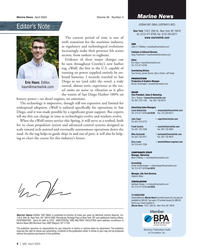 )
April 2024 - Marine News page: 4
)
April 2024 - Marine News page: 4new harbor Tel: 212-477-6700 tug, eWolf, the ? rst in the U.S. capable of Contributing Writers running on power supplied entirely by on- Tom Ewing, James Kearns, Barry Parker, Jeff Vogel board batteries. I recently traveled to San PRODUCTION Production & Graphics Manager Diego to see (and ride)
-
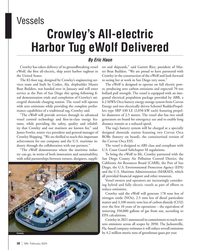 )
February 2024 - Marine News page: 38
)
February 2024 - Marine News page: 38distance transits at a reduced speed. ity that Crowley and our mariners are known for,” said The tug’s battery system will be charged at a specially James Fowler, senior vice president and general manager of designed shoreside station featuring two Corvus Orca Crowley Shipping. “We are thrilled to reach
-
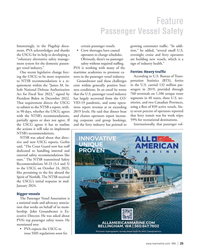 )
February 2024 - Marine News page: 25
)
February 2024 - Marine News page: 25said these challenges portation Statistics (BTS), ferries to NTSB recommendations is a re- in the U.S. carried 132 million pas- quirement within the “James M. In- exist within generally positive busi- hofe National Defense Authorization ness conditions. In an email he wrote sengers in 2019, provided
-
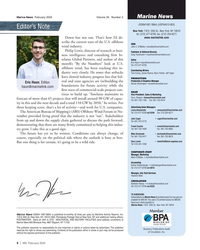 )
February 2024 - Marine News page: 4
)
February 2024 - Marine News page: 4look at U.S. Tel: 212-477-6700 offshore wind, has been tracking this in- Contributing Writers dustry very closely. He notes that setbacks Tom Ewing, James Kearns, Barry Parker, Jeff Vogel have slowed industry progress but that fed- PRODUCTION Production & Graphics Manager eral and state agencies
-
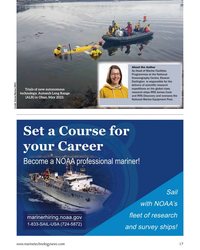 )
January 2024 - Marine Technology Reporter page: 17
)
January 2024 - Marine Technology Reporter page: 17Darlington is responsible for the delivery of scienti? c research expeditions on the global class Trials of new autonomous research ships RRS James Cook technology, Autosub Long Range and RRS Discovery and oversees the (ALR) in Oban, May 2023. National Marine Equipment Pool. Credit: Rachel
-
 )
January 2024 - Marine Technology Reporter page: 16
)
January 2024 - Marine Technology Reporter page: 16INSIGHTS SCIENCE RESEARCH MANAGEMENT Map of NOC vessel operations from April 2022 – March 2023. Green = RRS James Cook, Blue = RRS Discovery Credit: NOC bon output, with an ambition of reaching net zero by 2040. MFP to be able to undertake the same project management and international collaboration.
-
 )
January 2024 - Marine Technology Reporter page: 14
)
January 2024 - Marine Technology Reporter page: 14ice edges. As operators of two global class re- tion of instruments, personnel capabilities, and budget manage- search vessels (RRS Discovery and RRS James Cook) along- ment. NOC developed the Marine Facilities Planning (MFP) tool side the National Marine Equipment Pool (NMEP), NOC is a in collaboration
-
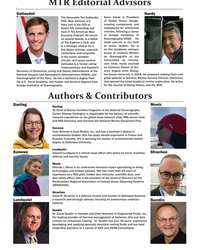 )
January 2024 - Marine Technology Reporter page: 6
)
January 2024 - Marine Technology Reporter page: 6Oceanography Center, Eleanor Darlington is responsible for the delivery of scienti? c research expeditions on the global class research ships RRS James Cook and RRS Discovery and oversees the National Marine Equipment Pool. Konowe Celia Konowe is from Reston, Va., and has a bachelor’s degree in
-
 )
November 2023 - Marine News page: 18
)
November 2023 - Marine News page: 18Column Legal Beat Bringing the Capital Construction Fund Program Ashore By James Kearns, Special Council, Jones Walker LLP On May 5, 2023, base amount, providing a total of more than $662 million the White House announced that the Environmental Pro- for FY 2023. The NOFOs that have been issued for
-
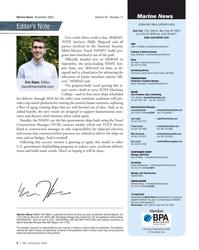 )
November 2023 - Marine News page: 4
)
November 2023 - Marine News page: 4NSMV, Em- Tel: 212-477-6700 pire State, was “delivered on time, as de- Contributing Writers signed and at a ? xed price for advancing the Tom Ewing, James Kearns, Barry Parker, Jeff Vogel education of future merchant marine of? - PRODUCTION Production & Graphics Manager cers,” MARAD said. Eric
-
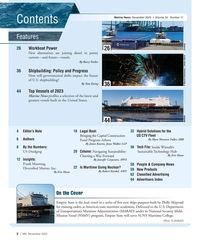 )
November 2023 - Marine News page: 2
)
November 2023 - Marine News page: 2for the Bringing the Capital Construction US CTV Fleet By Myra Shannon Fuller, ABB 6 Authors Fund Program Ashore By James Kearns, Jones Walker LLP 8 By the Numbers: 56 Tech File: Inside Wärtsilä’s US Dredging 20 Column: Navigating Sustainability:
-
 )
November 2023 - Maritime Reporter and Engineering News page: 23
)
November 2023 - Maritime Reporter and Engineering News page: 23systems do not have in supply chains until the shock of the Covid pandemic, said open APIs to integrate them. It could take up to 20 emails to James Pomeroy at HSBC, but that had changed now. order one spare part, he said. The last 12 months had seen a period of inventory rebuild- Seafarers, who
-
 )
November 2023 - Maritime Reporter and Engineering News page: 22
)
November 2023 - Maritime Reporter and Engineering News page: 22future changes.” Managing Director, Oceanly, included Peter Schellenberger, Empowerment of vessel control centers is also necessary Founder of Novamaxis, James Pomeroy, Global Economist, to achieve ef? ciency gains, he added, and “will drive mean- HSBC; and Marco Cristoforo Camporeale, Senior Director,
-
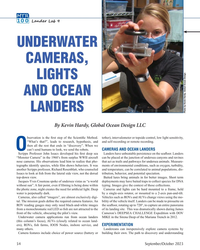 )
September 2023 - Marine Technology Reporter page: 54
)
September 2023 - Marine Technology Reporter page: 54, to capture an entire panorama from a monochromatic red LED so ? sh are not attracted to the of its landing site. This was dramatically shown during James front of the vehicle, obscuring the pilot’s view. Cameron’s DEEPSEA CHALLENGE Expedition with DOV Underwater camera applications run from ocean
-
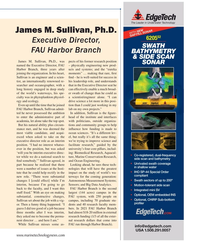 )
September 2023 - Marine Technology Reporter page: 35
)
September 2023 - Marine Technology Reporter page: 35James M. Sullivan, Ph.D. WITH NEW GAP FILL SONAR S2 6205 Executive Director, SWATH FAU Harbor Branch BATHYMETRY & SIDE SCAN James M. Sullivan, Ph.D., was pects of his former research position SONAR named the Executive Director, FAU – physically engineering new prod- Harbor Branch, three years after
-
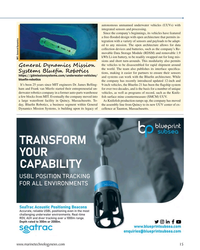 )
September 2023 - Marine Technology Reporter page: 15
)
September 2023 - Marine Technology Reporter page: 15the Blue? n architecture. While blue? n-robotics the company has recently introduced updated 12-inch and It’s been 25 years since MIT engineers Dr. James Belling- 9-inch vehicles, the Blue? n-21 has been the ? agship system ham and Frank van Mierlo started their entrepreneurial un- for over two decades
-
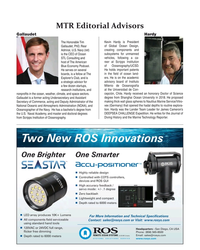 )
September 2023 - Marine Technology Reporter page: 7
)
September 2023 - Marine Technology Reporter page: 7that opened the hadal depths to routine explora- Oceanographer of the Navy. He has a bachelor’s degree from tion. Hardy was the Lander Team Leader for James Cameron’s the U.S. Naval Academy, and master and doctoral degrees DEEPSEA CHALLENGE Expedition. He writes for the Journal of from Scripps Institution
-
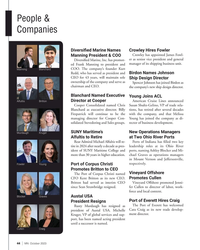 )
October 2023 - Marine News page: 44
)
October 2023 - Marine News page: 44People & Companies Diversi? ed Marine Names Crowley Hires Fowler Crowley has appointed James Fowl- Manning President & COO er as senior vice president and general Diversi? ed Marine, Inc. has promot- ed Frank Manning to president and manager of its shipping business unit. COO. The company’s founder
-
 )
October 2023 - Marine News page: 4
)
October 2023 - Marine News page: 4Haun • [email protected] Tel: 212-477-6700 • Biden’s Offshore Wind Target Slipping Out of Reach as Projects Struggle Contributing Writers Tom Ewing, James Kearns, Barry Parker, Jeff Vogel • BOEM Postpones Oil and Gas Lease PRODUCTION Sale 261 Production & Graphics Manager Eric Haun, Editor
-
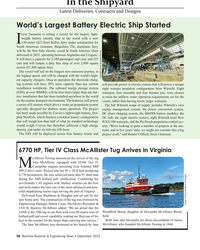 )
September 2023 - Maritime Reporter and Engineering News page: 58
)
September 2023 - Maritime Reporter and Engineering News page: 58, making our ? eet one of the ? eld. best in the country for the larger ships entering into service.” Both Jane and Alexandra are direct descendants of James The Jane McAllister was christened at her launch by Jane McAllister, who founded McAllister Towing in 1864. 58 Maritime Reporter & Engineering News
-
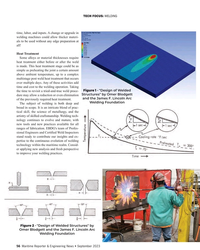 )
September 2023 - Maritime Reporter and Engineering News page: 56
)
September 2023 - Maritime Reporter and Engineering News page: 56- "Design of Welded the time to revisit a tried-and-true weld proce- dure may allow a reduction or even elimination Structures" by Omer Blodgett and the James F. Lincoln Arc of the previously required heat treatment. Welding Foundation The subject of welding is both deep and broad in scope. It is an intricate
-
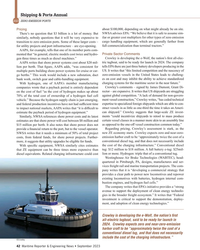 )
September 2023 - Maritime Reporter and Engineering News page: 42
)
September 2023 - Maritime Reporter and Engineering News page: 42charging systems for the maritime sector in the near future.” companies wrote that a payback period is entirely dependent Crowley’s comments – signed by James Dumont, Grant Di- on the cost of fuel “as the cost of hydrogen makes up about rector – are expansive. It writes that US shipyards are struggling 70%
